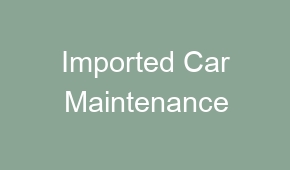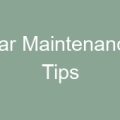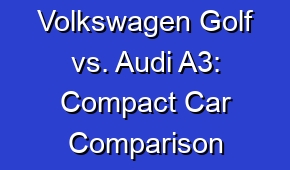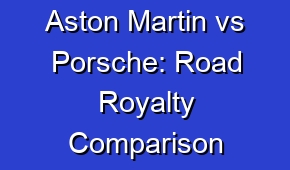Imported Car Maintenance

Summary: Maintenance for imported cars involves regular servicing, oil changes, tire rotations, and brake inspections to ensure optimal performance and longevity.
Imported car maintenance is crucial to keep your vehicle running smoothly and efficiently. Regular car maintenance is essential to prevent costly repairs in the future. When it comes to imported cars, it is important to find a specialized mechanic who is experienced in handling these types of vehicles. They have the knowledge and expertise to perform routine maintenance such as oil changes, tire rotations, and brake inspections. Additionally, they can identify and address any potential issues specific to imported cars. By investing in regular imported car maintenance, you can prolong the lifespan of your vehicle and ensure optimal performance on the road.
| Regular car maintenance is essential for imported cars to ensure their optimal performance. |
| Follow the recommended service schedule provided by the car manufacturer for proper maintenance. |
| Use high-quality imported car parts to maintain the authenticity and performance of your vehicle. |
| Keep the engine oil and fluids regularly checked and changed to avoid potential damage. |
| Regularly inspect and replace brake pads and tires to ensure safety and optimal driving conditions. |
- Imported cars may require specialized diagnostic tools for accurate maintenance and repairs.
- Pay attention to electrical components and wiring to prevent issues with the car’s electrical system.
- Imported car warranties often have specific maintenance requirements that should be followed.
- Regularly clean and protect the car’s exterior to maintain its appearance and prevent damage.
- Seek the expertise of certified mechanics experienced in maintaining and repairing imported cars.
What are the common maintenance tasks for imported cars?
Maintaining an imported car involves regular tasks such as oil changes, tire rotations, and brake inspections. Additionally, it is crucial to check the vehicle’s fluids regularly, including the coolant, transmission fluid, and brake fluid. Regular air filter replacement is also necessary to ensure optimal performance.
How often should I change the oil in my imported car?
The frequency of oil changes depends on various factors, including the car’s make, model, and mileage. As a general guideline, it is recommended to change the oil every 3,000 to 5,000 miles or every three to six months to maintain engine health and efficiency.
What should I consider when choosing a mechanic for imported car maintenance?
When selecting a mechanic for imported car maintenance, it is essential to consider their expertise in working with imported vehicles. Look for mechanics who have experience with your specific car’s make and model. Additionally, ensure they use high-quality parts and fluids and offer warranties on their work.
How often should I replace the air filter in my imported car?
The frequency of air filter replacement depends on various factors, including the car’s make, model, and driving conditions. Generally, it is recommended to replace the air filter every 12,000 to 15,000 miles or as advised in the vehicle’s owner’s manual.
What type of fuel should I use for my imported car?
It is crucial to use the recommended fuel type specified by the car’s manufacturer. Using the wrong fuel can negatively impact the engine’s performance and potentially cause damage.
How often should I check the tire pressure on my imported car?
Regularly checking the tire pressure is important for optimal safety and performance. It is recommended to check the tire pressure monthly and adjust it according to the recommended levels specified in the car’s owner’s manual or on the driver’s side door jamb.
What are the signs that my imported car needs new brake pads?
Several signs indicate the need for new brake pads, including squeaking or grinding noises when braking, reduced braking performance, and vibrations or pulsations felt through the brake pedal. If you notice any of these signs, it is important to have the brake pads inspected and replaced if necessary.
How often should I replace the spark plugs in my imported car?
The frequency of spark plug replacement depends on various factors, including the car’s make, model, and recommended maintenance schedule. Generally, it is recommended to replace spark plugs every 30,000 to 100,000 miles or as advised in the vehicle’s owner’s manual.
What should I do if my imported car’s check engine light comes on?
If the check engine light illuminates, it is important to diagnose the issue as soon as possible. Visit a trusted mechanic or use an OBD-II scanner to retrieve the error codes. Ignoring the check engine light can lead to further damage and costly repairs.
How often should I replace the timing belt in my imported car?
The timing belt replacement interval varies depending on the car’s make, model, and engine type. Generally, it is recommended to replace the timing belt every 60,000 to 100,000 miles or as advised in the vehicle’s owner’s manual. Failure to replace a worn timing belt can result in severe engine damage.
What should I do if my imported car’s battery dies?
If the car’s battery dies, you can try jump-starting it using jumper cables and another vehicle. Alternatively, call a roadside assistance service or a mechanic to test the battery and determine if it needs charging or replacement.
How often should I flush and replace the coolant in my imported car?
The recommended coolant flush interval varies depending on the car’s make, model, and coolant type. Generally, it is recommended to flush and replace the coolant every two to five years or as advised in the vehicle’s owner’s manual. This helps prevent engine overheating and corrosion.
What are the benefits of regular imported car maintenance?
Regular maintenance keeps your imported car running smoothly, improves fuel efficiency, extends the lifespan of components, enhances safety, and maintains the vehicle’s value over time.
How often should I rotate the tires on my imported car?
Tire rotation frequency varies depending on factors such as the car’s drivetrain and driving conditions. As a general guideline, it is recommended to rotate the tires every 5,000 to 8,000 miles or as advised in the vehicle’s owner’s manual. This promotes even tire wear and extends tire life.
What are the signs of a failing alternator in my imported car?
Signs of a failing alternator include dimming headlights, electrical issues such as dead battery or malfunctioning accessories, and dashboard warning lights. If you experience these symptoms, have the alternator tested and replaced if necessary.
How often should I replace the cabin air filter in my imported car?
The cabin air filter replacement interval varies depending on the car’s make, model, and driving conditions. Generally, it is recommended to replace the cabin air filter every 12,000 to 15,000 miles or as advised in the vehicle’s owner’s manual. This ensures clean air inside the cabin.
What should I do if my imported car’s air conditioning system isn’t cooling?
If the air conditioning system isn’t cooling properly, it may need recharging or repairs. Visit a qualified mechanic who can inspect the system for leaks, check the compressor, and recharge the refrigerant if necessary.
How often should I replace the brake fluid in my imported car?
The brake fluid replacement interval varies depending on the car’s make, model, and driving conditions. Generally, it is recommended to replace the brake fluid every two to three years or as advised in the vehicle’s owner’s manual. Regular brake fluid changes help maintain braking performance.
What should I do if my imported car’s transmission is slipping?
If the transmission is slipping, it is important to have it inspected and diagnosed by a professional mechanic. They can determine the cause, which may range from low fluid levels to more significant issues, and perform the necessary repairs.





















